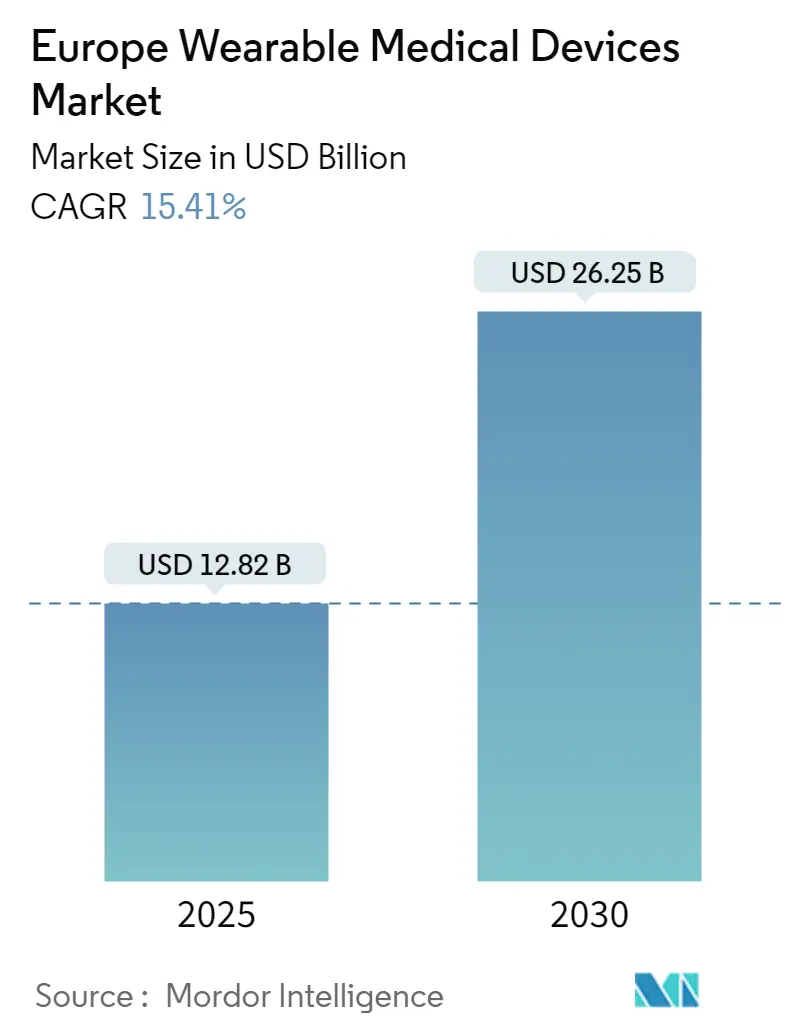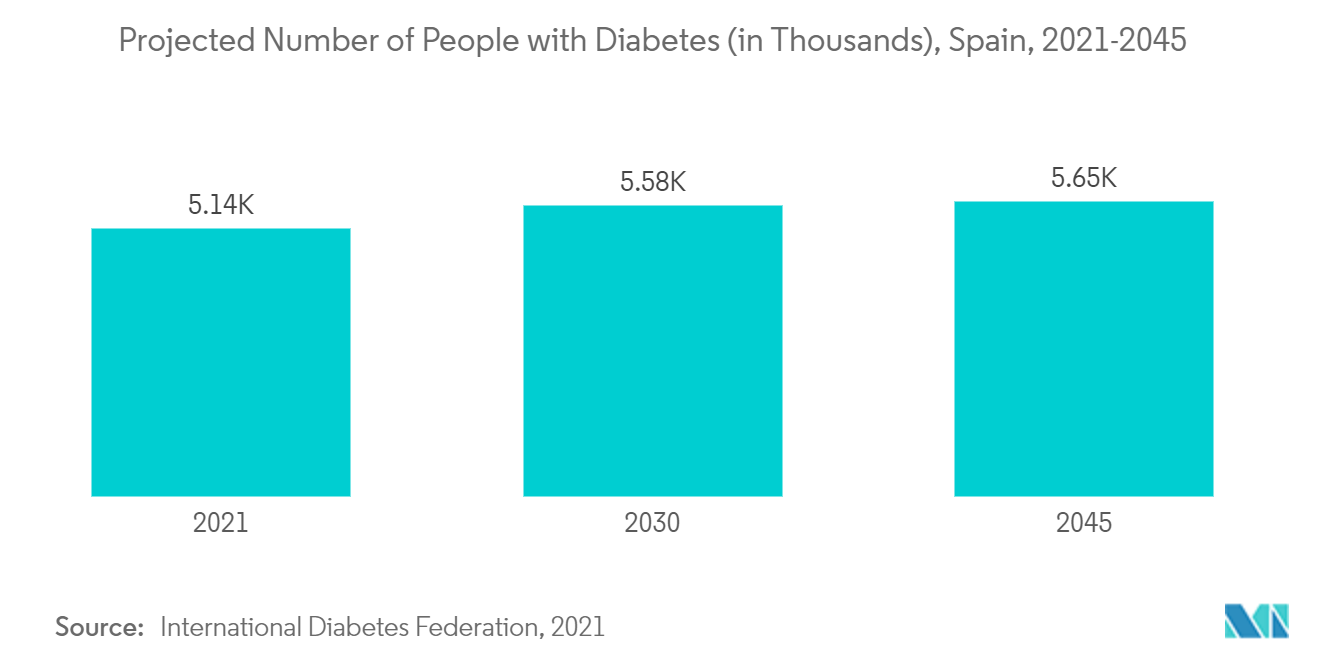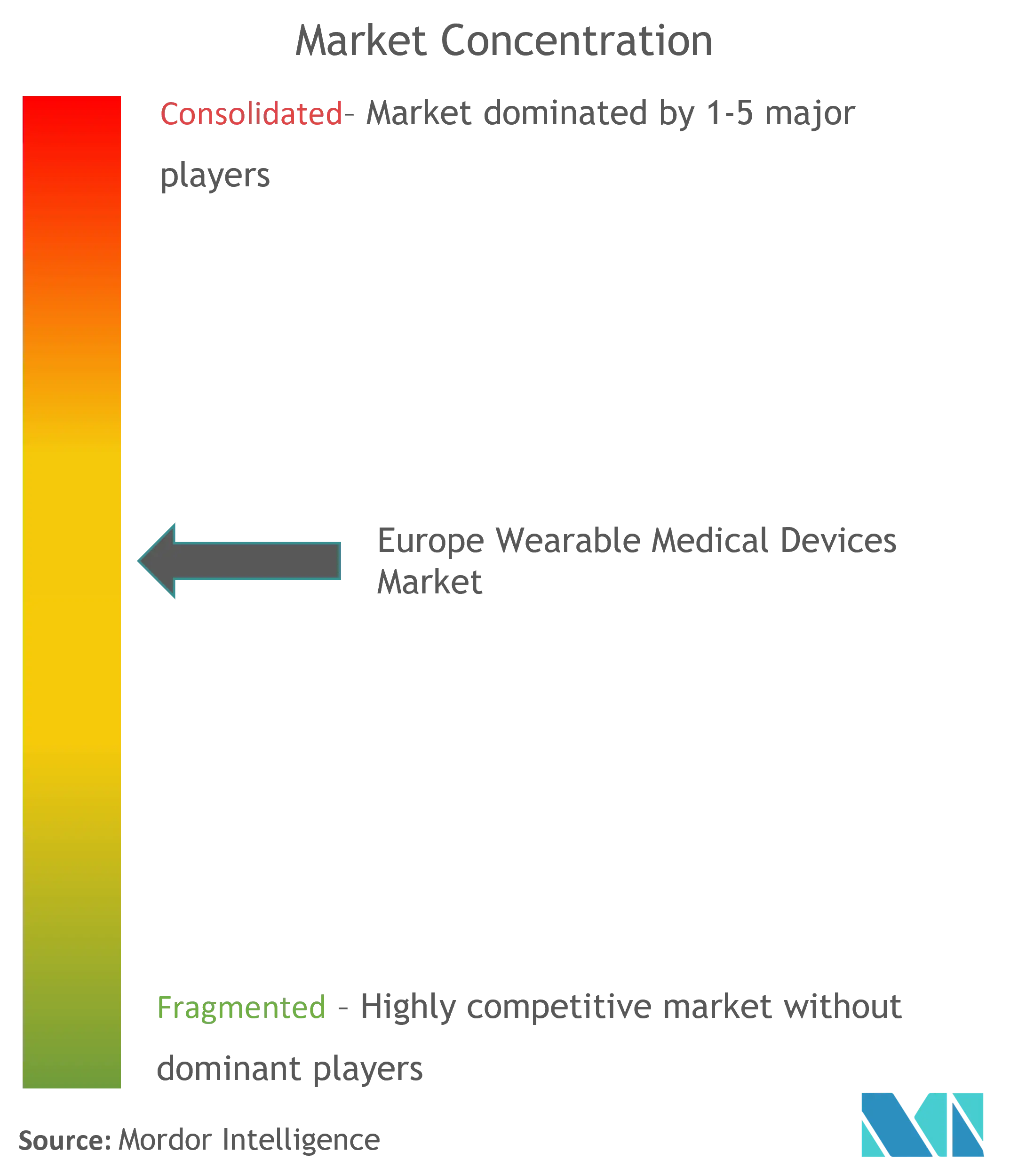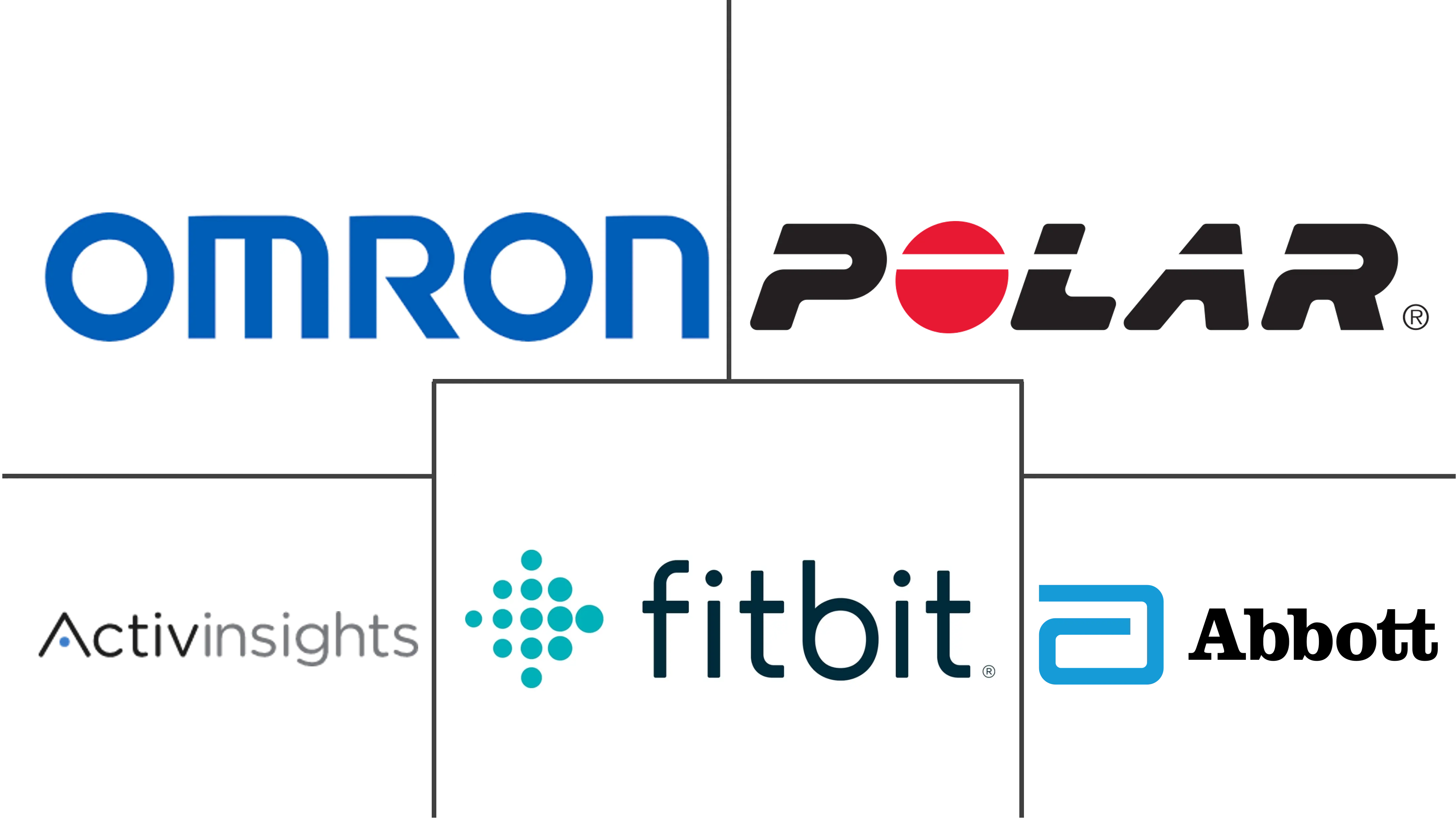
Europe Wearable Medical Devices Market Analysis
The Europe Wearable Medical Devices Market size is estimated at USD 12.82 billion in 2025, and is expected to reach USD 26.25 billion by 2030, at a CAGR of 15.41% during the forecast period (2025-2030).
The COVID-19 pandemic has significantly impacted market growth. The demand for wearable devices and patient monitoring devices has increased during the pandemic period as they allow contactless communication and tracking of medical conditions by clinicians. The spread and early diagnosis of COVID-19 can be determined through the remote monitoring of vital signs such as skin and body temperature, respiratory rate, pulse rate, heart rate, and blood oxygen level, which are related to COVID-19. This is anticipated to have a positive effect on the growth of the studied market. For instance, according to an article published by The Lancet Digital Health Journal, in April 2022, titled "Effectiveness and safety of pulse oximetry in remote patient monitoring of patients with COVID-19: a systematic review", it has been found that pulse oximetry is a practical method for determining whether patients need hospital treatment or may be safely handled at home by remotely monitoring their SpO2 levels.
In addition, as per the same source, in the United Kingdom, COVID Oximetry @home15 is a national program of care for patients with COVID-19 in England. The program aims to monitor SpO2 remotely in patients who are at the risk of worsening from silent hypoxia. Also, the model seeks to improve patient care and ensure more efficient use of National Health Service resources. Hence, the increased usage of remote patient monitoring devices and other wearable devices to monitor health conditions during pandemics has positively impacted the market growth. Similarly, according to a study published in Nature Electronics, in January 2021, titled "Wearable devices for the detection of COVID-19," the early diagnosis of asymptomatic and presymptomatic COVID-19 cases can be accomplished by using wearable electronic devices that continuously monitor physiological data. Thus, the increasing use of wearable devices in diagnosing and detecting the COVID-19 symptoms and monitoring the health condition of various patients suffering from chronic diseases is expected to increase the adoption of these devices among the population, which in turn is expected to increase the market growth during the COVID-19 pandemic.
Certain factors that are driving the market growth are rising technological advancements and product innovation, increasing health awareness among the population, and advantages offered by the wearable devices such as ease of use and data interpretation.
Other factors, such as continuous product development and commercialization, and strengthening distribution channels of major product manufacturers are expected to aid the growth of the Europe wearable medical devices market. For instance, in December 2021, Xiaomi launched Redmi Watch 2 Lite smartwatch in the European market, Germany for EUR 79. It supports several features, including tracking blood oxygen levels, steps taken, and heart rate. Also, in April 2020, Withings launched the latest sleep-tracking device, Sleep Analyzer, a mat that can be used to detect sleep apnea. The device analyzes sleep and snoring episodes by using its advanced sensors when placed underneath a mattress.
Furthermore, the increasing initiatives to rise health awareness regarding various chronic diseases among the population in the region are also contributing to the growth of the studied market over the forecast period. For instance, in December 2021, the European Commission launched the Healthier Together - EU non-communicable diseases (NCD) initiative to support European countries in identifying and implementing effective policies and actions to reduce the burden of major NCDs and improve citizens' health and well-being. The initiative includes five strands such as health determinants, cardiovascular diseases, diabetes, chronic respiratory diseases, mental health, and neurological disorders.
However, the lack of reimbursement policies in Europe is likely to restrain the market growth over the forecast period.
Europe Wearable Medical Devices Market Trends
Remote Patient Monitoring Segment is Expected to Grow Rapidly Over the Forecast Period in the Europe Wearable Medical Devices Market
Remote patient monitoring (RPM) devices allow providers to monitor, report and analyze their patient's acute or chronic conditions from outside the hospital or clinic setting. They enable the practitioner to have a real-time understanding of the patient's disease state and take preventative clinical actions. The remote patient monitoring segment is expected to witness significant growth over the forecast period owing to the factors such as the rising prevalence of chronic diseases such as cardiovascular diseases, diabetes, hypertension, respiratory diseases, neurological diseases, and others, rising adoption of these devices, and growing geriatric population.
The rising burden of chronic diseases among the population is the key factor driving the demand for remote patient monitoring devices. For instance, according to the 2022 statistics published by the International Diabetes Federation in the 10thedition of 2021, in Germany, 6,199.9 thousand people were living with diabetes, in 2021. In addition, as per the same source, this number is projected to reach 6,519.7 thousand by 2030. The high blood sugar caused by diabetes can damage the nerves that control the heart and blood vessels, leading to a variety of cardiovascular diseases like coronary artery disease and stroke, which can narrow the arteries. Additionally, according to the British Heart Foundation England Factsheet, published in January 2022, about 6.4 million people are living with cardiovascular diseases in England in 2022. Also, as per the British Heart Foundation 2020 fact sheet, around 7.4 million people were living with heart and circulatory diseases in the United Kingdom. Thus, increasing the demand for effective monitoring to control the condition by measuring critical risk indicators, such as glucose, blood pressure, etc, is expected to increase the segment growth.
As per Germany Federal Statistical Office 2020 report, the total population in Germany was 83 million in 2020, of these 16.2 million population were above 67 years of age. In addition, as per the same source, this number is projected to reach 21.4 million in 2040. The rising geriatric population who are more prone to develop chronic diseases is expected to increase the demand for remote patient monitoring devices as well as increase the adoption of these wearable devices due to their easy usage.
Implementation of RPM can improve the management of chronic diseases by measuring critical risk indicators, such as glucose, blood pressure, etc. RPM has various benefits for end-users and hospitals, such as low cost of healthcare, reduction in extended hospitalization, and fewer doctor appointments, among others. This can also help to reduce the cost associated with the treatment of chronic diseases. Thus, owing to the above factors the segment is expected to show growth in the coming years.

Europe Wearable Medical Devices Industry Overview
The Europe Wearable Medical Devices Market is moderately consolidated competitive. The companies are adopting different strategies to maintain their position in the market. Some of the key players in the market are Abbott Laboratories, Activinsights Ltd, Fitbit, Inc., Garmin Ltd., Intelesens Ltd., Koninklijke Philips NV, Nuubo, Omron Corporation, and Polar Electro Oy.
Europe Wearable Medical Devices Market Leaders
-
Omron Corporation
-
Polar Electro Oy
-
Fitbit, Inc
-
Abbott Laboratories
-
Activinsights Ltd.
- *Disclaimer: Major Players sorted in no particular order

Europe Wearable Medical Devices Market News
- IN March 2022, Infineon Technologies AG in collaboration with Sleepiz AG launched Infineon XENSIV 60 GHz radar technology, integrated into smart home and healthcare devices, that offers a great opportunity for healthcare applications as they allow to accurately measure vital signs such as heartbeat and breathing rate without touching the body.
- In February 2022, Oppo launched a smartwatch, Oppo Watch Free, in the European market. The fitness tracker can monitor more than 100 sports modes including cricket, skipping, archery, skiing, volleyball, kayaking, and badminton. The fitness tracker can automatically track only four sports - running, walking, rowing (machine), and ellipticals. Additionally, the OPPO Watch Free has a SpO2 sensor, for measuring blood oxygen levels and a heart rate monitor that alerts users when their heart rates are abnormally high or low, sleep tracking and snoring detection.
Europe Wearable Medical Devices Industry Segmentation
As per the scope of the report, wearable medical devices are autonomous devices capable of diagnosing or monitoring medical conditions, combined with digital health information, typically worn over the body. These devices possess features, such as noninvasive physiological sensors, data processing modules, medical feedback, and wireless data transmission capabilities. The Europe Wearable Medical Devices Market is segmented by Device Type (Monitoring Devices and Therapeutic Devices), Application (Sports and Fitness, Remote Patient Monitoring, and Home Healthcare), Product Type (Watch, Wristband, Ear Wear, and Other Product Types), and Geography. The report offers the value (in USD million) for the above segments.
| By Device Type | Monitoring Devices | Vital Sign Monitoring Devices | |
| Sleep Monitoring Devices | |||
| Electrocardiographs, Fetal and Obstetric Devices | |||
| Neuromonitoring Devices | |||
| Therapeutic Devices | Pain Management Devices | ||
| Rehabilitation Devices | |||
| Respiratory Therapy Devices | |||
| Other Theraputic Devices | |||
| By Application | Sports and Fitness | ||
| Remote Patient Monitoring | |||
| Home Healthcare | |||
| By Product Type | Watch | ||
| Wristband | |||
| Ear Wear | |||
| Other Product Types | |||
| Geography | Germany | ||
| United Kingdom | |||
| France | |||
| Italy | |||
| Spain | |||
| Rest of Europe | |||
Europe Wearable Medical Devices Market Research FAQs
How big is the Europe Wearable Medical Devices Market?
The Europe Wearable Medical Devices Market size is expected to reach USD 12.82 billion in 2025 and grow at a CAGR of 15.41% to reach USD 26.25 billion by 2030.
What is the current Europe Wearable Medical Devices Market size?
In 2025, the Europe Wearable Medical Devices Market size is expected to reach USD 12.82 billion.
Who are the key players in Europe Wearable Medical Devices Market?
Omron Corporation, Polar Electro Oy, Fitbit, Inc, Abbott Laboratories and Activinsights Ltd. are the major companies operating in the Europe Wearable Medical Devices Market.
What years does this Europe Wearable Medical Devices Market cover, and what was the market size in 2024?
In 2024, the Europe Wearable Medical Devices Market size was estimated at USD 10.84 billion. The report covers the Europe Wearable Medical Devices Market historical market size for years: 2019, 2020, 2021, 2022, 2023 and 2024. The report also forecasts the Europe Wearable Medical Devices Market size for years: 2025, 2026, 2027, 2028, 2029 and 2030.
Our Best Selling Reports
Europe Wearable Medical Devices Industry Report
Statistics for the 2025 Europe Wearable Medical Devices market share, size and revenue growth rate, created by Mordor Intelligence™ Industry Reports. Europe Wearable Medical Devices analysis includes a market forecast outlook for 2025 to 2030 and historical overview. Get a sample of this industry analysis as a free report PDF download.



